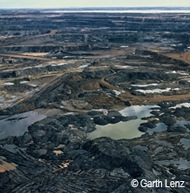
| Toxic Mercury Ring Surrounds Tar Sands | 3 January 14 |

Mercury can bioaccumulate in living creatures and chronic exposure can cause brain damage. Environment Canada scientists are sampling everything from snow to lichens to bird eggs as part of the federal-provincial joint oilsands monitoring program. The scientists stress the mercury loadings around the oilsands are low compared to the contamination seen in many parts of North America including southern industrial Ontario and southern Quebec. Mercury is "the number one concern" when it comes to the metal toxins generated by oilsands operations and a major worry for aboriginal and environmental groups concerned about the oilsands' impact on fishing, hunting and important wildlife staging areas downstream of the oilsands. Canada recently signed an international treaty pledging to reduce mercury emissions. View December 31, 2013 Vice articleView December 31, 2013 The Christian Post article View December 30, 2013 Vancouver Observer article View December 29, 2013 Aljazeera America article View December 29, 2013 Canada.com article View October 14, 2013 The Globe and Mail article |
|
 Print version Print version |
Top |
